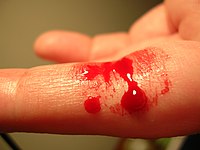
Photo from wikipedia
In Response: We thank Dr Xu for his interest in our recent study. We agree upon the value of examining microglial expression of anti-inflammatory markers given their potential effects of… Click to show full abstract
In Response: We thank Dr Xu for his interest in our recent study. We agree upon the value of examining microglial expression of anti-inflammatory markers given their potential effects of neuroprotection, depending the on timing and stage of disease. Although commonly used in microglia research literature, the terminology of M1 and M2 phenotypes derived from macrophage polarization is being questioned because microglial polarization has not been conclusively established by research findings. Recent transcriptomic and proteomic profiling of microglia reveals that classifying microglia as either M1 or M2 appears to oversimplify the varied activation states that microglia may undergo. That being said, the activation of microglia can be seen on a spectrum, and they will not simply fall into M1/M2 categories. Therefore, we assessed the expression of anti-inflammatory markers (CD [cluster of differentiation] 206, IL [interleukin]-4, and TGF [transforming growth factor]-β), along with the proinflammatory markers (CD86, IL-1β, and TNF [tumor necrosis factor]-α), in microglia as a whole. Our results suggest that astrocytic IL-15 preferentially upregulates the proinflammatory markers but not the anti-inflammatory markers in microglia following intracerebral hemorrhage. Dr Xu’s correspondence suggests that the activation of microglia by IL-15 in the setting of intracerebral hemorrhage might involve the disruption of blood-brain barrier following intracerebral hemorrhage. Since astrocytic IL-15 does not significantly alter microglial activity and neurovascular structure under physiological conditions, it is reasonable to infer that IL-15 supplements environmental factors including hematomal and blood components, to boost microglia response after intracerebral hemorrhage. Due to its tremendous impact on central nervous system immunity, blood-brain barrier disruption could be involved in such process and factored into the effects of IL-15 on microglia. Further investigation on this direction is warranted in future studies.
Journal Title: Stroke
Year Published: 2020
Link to full text (if available)
Share on Social Media: Sign Up to like & get
recommendations!